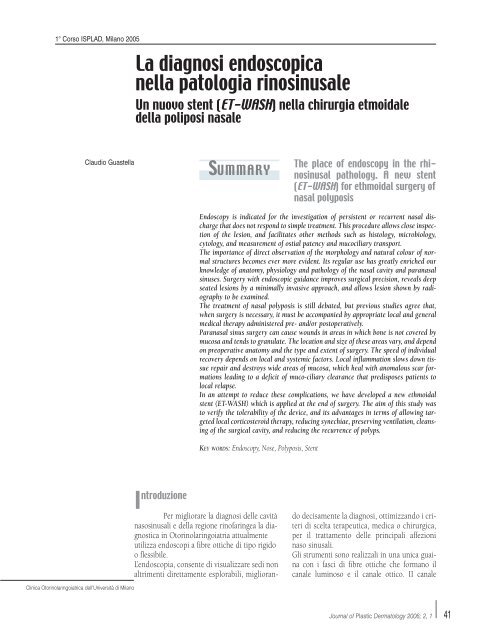Aprile Vol.2 N° 1 - 2006 - Salute per tutti
Aprile Vol.2 N° 1 - 2006 - Salute per tutti
Aprile Vol.2 N° 1 - 2006 - Salute per tutti
Create successful ePaper yourself
Turn your PDF publications into a flip-book with our unique Google optimized e-Paper software.
1° Corso ISPLAD, Milano 2005<br />
Clinica Otorinolaringoiatrica dell’Università di Milano<br />
La diagnosi endoscopica<br />
nella patologia rinosinusale<br />
Un nuovo stent (ET-WASH) nella chirurgia etmoidale<br />
della poliposi nasale<br />
Claudio Guastella<br />
SUMMARY<br />
The place of endoscopy in the rhinosinusal<br />
pathology. A new stent<br />
(ET-WASH) for ethmoidal surgery of<br />
nasal polyposis<br />
Endoscopy is indicated for the investigation of <strong>per</strong>sistent or recurrent nasal discharge<br />
that does not respond to simple treatment. This procedure allows close inspection<br />
of the lesion, and facilitates other methods such as histology, microbiology,<br />
cytology, and measurement of ostial patency and mucociliary transport.<br />
The importance of direct observation of the morphology and natural colour of normal<br />
structures becomes ever more evident. Its regular use has greatly enriched our<br />
knowledge of anatomy, physiology and pathology of the nasal cavity and paranasal<br />
sinuses. Surgery with endoscopic guidance improves surgical precision, reveals deep<br />
seated lesions by a minimally invasive approach, and allows lesion shown by radiography<br />
to be examined.<br />
The treatment of nasal polyposis is still debated, but previous studies agree that,<br />
when surgery is necessary, it must be accompanied by appropriate local and general<br />
medical therapy administered pre- and/or posto<strong>per</strong>atively.<br />
Paranasal sinus surgery can cause wounds in areas in which bone is not covered by<br />
mucosa and tends to granulate. The location and size of these areas vary, and depend<br />
on preo<strong>per</strong>ative anatomy and the type and extent of surgery. The speed of individual<br />
recovery depends on local and systemic factors. Local inflammation slows down tissue<br />
repair and destroys wide areas of mucosa, which heal with anomalous scar formations<br />
leading to a deficit of muco-ciliary clearance that predisposes patients to<br />
local relapse.<br />
In an attempt to reduce these complications, we have developed a new ethmoidal<br />
stent (ET-WASH) which is applied at the end of surgery. The aim of this study was<br />
to verify the tolerability of the device, and its advantages in terms of allowing targeted<br />
local corticosteroid therapy, reducing synechiae, preserving ventilation, cleansing<br />
of the surgical cavity, and reducing the recurrence of polyps.<br />
KEY WORDS: Endoscopy, Nose, Polyposis, Stent<br />
I ntroduzione<br />
Per migliorare la diagnosi delle cavità<br />
nasosinusali e della regione rinofaringea la diagnostica<br />
in Otorinolaringoiatria attualmente<br />
utilizza endoscopi a fibre ottiche di tipo rigido<br />
o flessibile.<br />
L’endoscopia, consente di visualizzare sedi non<br />
altrimenti direttamente esplorabili, miglioran-<br />
do decisamente la diagnosi, ottimizzando i criteri<br />
di scelta terapeutica, medica o chirurgica,<br />
<strong>per</strong> il trattamento delle principali affezioni<br />
naso sinusali.<br />
Gli strumenti sono realizzali in una unica guaina<br />
con i fasci di fibre ottiche che formano il<br />
canale luminoso e il canale ottico. II canale<br />
Journal of Plastic Dermatology <strong>2006</strong>; 2, 1 41

















